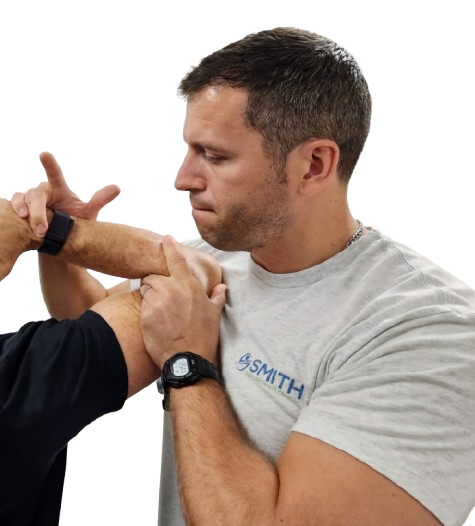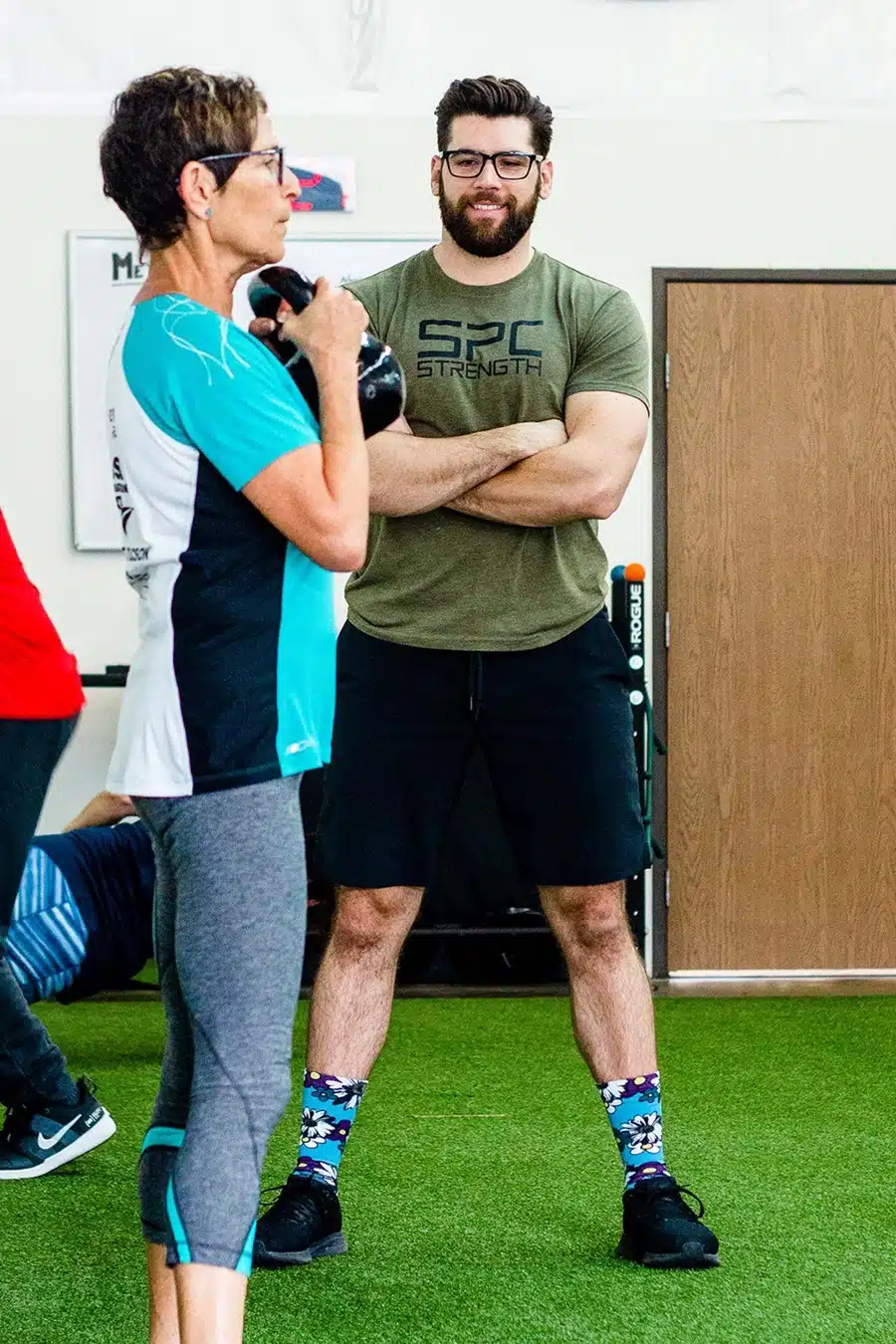Physical therapy quality is highly inconsistent between clinicians, clinics, and companies. Numerous factors play into these discrepancies, including clinical process, management structure, payment models, clinician-patient time, use of assistants, patient load, clinician training, and business models. These issues often culminate in underwhelming rehabilitation outcomes for clients.
When embarking on a rehab journey, most patients don’t anticipate these issues. As Sarah Smith, PT, DPT, and co-founder of Smith Performance Center, observes: “Many patients don’t know where to start their rehab journey, and physical therapy is often not their first choice.” Choosing a clinic that treats 25 patients daily with heavy use of assistants is vastly different from one that sees six patients daily with dedicated one-on-one time.

From our experience, three key areas drive these differences: Process, Patient-Provider Relationship, and Clinical Skill. Clinics that avoid assistant use, emphasize and support clinician performance, create a team structure with constant case reviews and quality control processes, and focus on patient empowerment inherently deliver better outcomes. By contrast, a clinic loaded with insurance-dependent processes, heavy patient volume, minimal to no training outside of required continuing education, and minimal clinical time yields subpar results—no matter the clinicians’ training or intentions. The business model steamrolls the best of intentions and training.
As a consumer, understanding these factors can help you choose a clinic that’s structured to deliver the results you need.
Process: The Foundation of Quality Care
To understand why these issues persist, let’s begin with the foundational element of any effective rehabilitation experience: a clear, structured process. A “process” encompasses the entire pathway a healthcare provider and team follow, from your first interaction to the end of your care. Surprisingly, many healthcare facilities lack a unified, well-defined process. Without it, each provider or support staff essentially operates independently, resulting in inconsistent care, repeated errors, and missed opportunities to build on effective practices.
At Smith Performance Center, we call our structured approach the SPC Phase System. Rather than prescribing each step, this system supports clinicians with a clear framework, allowing them to be more present with patients and reduce mental strain during sessions. It is a living model designed to improve continuously, with weekly meetings, case reviews, and quality controls built into our process.
Main Issues When Process is Absent or Inadequate
- Lack of Consistent Clinical Approach: Care standards can vary widely depending on the clinician or assistant, confusing the patient journey.
- Wrong Provider at the Wrong Time: Without a defined process, patients may not access the level of care or specialist required for their needs. In other words, patients can get stuck in a non-progress loop, repeating the same ineffective treatments without real benefit.
- Team Inconsistencies: Inconsistent workflows among team members can hinder patient progress. This often includes a lack of shared language or even completely different treatment philosophies, as clinics and businesses sometimes outsource their team development to continuing education companies.
- Absence of Quality Control: Without regular assessments, errors or ineffective methods go unchecked. At SPC, we hold weekly two-hour case reviews to address any issues, which often lead to co-treats, second opinions, or referrals to trusted providers.
- No Outcome Tracking: Without tracking results, clinicians miss crucial feedback for continuous improvement. It is from this data that we present at conferences on the patient management process and reduction in physical therapy needed with open clinic use.
For example, many patients report spending months doing exercises with a tech, only to find that these routines worsened their pain. By contrast, the SPC Phase System ensures the right provider is involved, referrals are made when needed, and clinician performance standards are actively monitored. Quality issues are identified and discussed weekly, reinforcing clinical excellence.
This doesn’t mean every person who comes through will avoid flare-ups or setbacks, but it does mean that these will be recognized and addressed promptly. Ultimately, a robust process like the SPC Phase System is much more than a protocol; it is a dynamic system of accountability and improvement that elevates the quality of care and patient outcomes.
Patient-Provider Relationship
Of course, a structured process alone is not enough; it must be coupled with a strong, trusting patient-provider relationship to truly drive meaningful progress. The patient-provider relationship is grounded in mutual trust: patients trust the provider to act in their best interest, while providers trust the patient to follow the prescribed care plan and communicate their experiences. This dynamic relationship builds over time, requiring both sides to be supported and engaged. The provider must be well-rested and mentally fresh, not overloaded, while the patient needs to feel heard, with their specific concerns addressed at the right time.
As discussed in the previous section, process impacts this relationship immensely. Many tools can help strengthen it, while certain clinical and business practices can also undermine it. Practitioner overload, for example, often stems from poor clinical processes, excessive patient volume, and insufficient managerial support—all of which can erode the quality of care. A good bedside manner is meaningless if a patient only receives 15 minutes of attention every few sessions.
Main Issues in the Patient-Provider Relationship
- Practitioner Overload: Without proper tools and support, practitioners may face overwhelming documentation requirements, high patient loads, and minimal recovery time, leading to diminished mental freshness and patient engagement.
- Lack of Independent Patient Reporting System: Patients may feel uncomfortable expressing concerns about progress face-to-face, meaning valuable feedback is lost. An independent reporting system empowers patients to share their experiences openly.
- Excessive Focus on Provider Treatment over Patient Empowerment: When providers don’t equip patients with the skills to manage their health, patients lose the agency to take ownership of their recovery journey.
- Poor Patient-Provider Communication: Limited time and lack of psychological safety prevent discussions about complex issues, such as central pain modulation or hidden triggers that might stall progress.
- Lack of Support Outside Physical Therapy Sessions: Without phone calls or additional coaching support between sessions, the continuity of care is weakened, hindering patients’ adherence to the plan of care.
Ultimately, a strong patient-provider relationship extends beyond in-session treatment. It requires mutual trust, support, and open communication to create an empowering recovery journey for the patient and a sustainable, rewarding experience for the provider.
Sarah Smith, PT, DPT, co-founder of Smith Performance Center, emphasizes this importance, saying: “Patients have to trust you and see that you’re truly invested in their best interests. They need to feel that you’re a part of their journey and that you genuinely understand their issues and what they are experiencing.”
Clinical Skill
While process and relationship form the backbone of successful rehabilitation, the clinician’s skill set is what ultimately brings these elements to life in the treatment room. When rehabilitation doesn’t yield great results, clinical skill is often the first area patients and providers scrutinize. However, we find that a lack of process and poor patient-provider relationships are frequently the root causes. This is why we discuss these foundational issues first; without them, clinicians rarely receive actionable feedback, which limits their growth and leads to skill stagnation. Many practices operate as “medical islands”—without a referral system, awareness of their outcomes, or a structured plan for skill development. This isolation results in repeated diagnostic errors, technique mistakes, and home plans that fail to make a meaningful impact.
For example, we know that patients with the same diagnosis don’t always respond identically to the same treatment. To address this, we use a tool called the treatment hierarchy. This approach allows for rapid testing of different treatments to identify which provides the most significant symptom improvement, guiding the initial course of care. Implementing this tool requires a significant investment in skills across various domains, from tissue-specific treatments to neuromuscular activation and targeted movement training.
Systematic skill development is essential for continuous improvement and effective patient care. Without it, progress is unlikely.
Key Clinical Skill Issues
- Diagnostic Errors: Misdiagnoses lead to ineffective treatments. Diagnosis is always probabilistic and must be refined throughout the rehab process.
- Home Plan Mistakes: Patients receive plans that don’t address their evolving needs. Effective home plans require understanding patient motivation, prompts, and training for successful execution.
- Poor Treatment Selection: Treatment choices may be poorly matched to the patient’s condition and should be adapted as new information about the patient’s condition emerges. Additionally, treatment should avoid siloing—a tendency for practitioners to apply a single tool across all conditions.
- Treatment Technique Issues: Errors in execution can significantly reduce the effectiveness of interventions.
- Medical Islands: Isolated clinicians lose valuable feedback from others dealing with similar cases, limiting their ability to adopt best practices.
- Absent Referral System: Without a referral pathway, clinicians miss opportunities for input from other experts.
- Missed Red Flags: Serious underlying issues may go unrecognized, compromising patient outcomes.
Clinical skill is not static—it must evolve through feedback, process integration, and a structured approach to development. This approach ensures clinicians can grow and improve, ultimately offering patients the best care possible.

Resolving the Major Issues in Physical Therapy and Rehab
Addressing these challenges requires a systematic approach throughout the rehabilitation journey:
- A Clear Process: The rehab process should be well-defined, continually refined, and consistently implemented.
- Respect for the Patient-Provider Relationship: This relationship should be honored as a foundation of effective care, not used cynically to increase revenue.
- Support for Clinical Skill Development: Each provider’s clinical skill should be enhanced through ongoing feedback and supportive clinical systems.
As a patient, you may recognize a facility that lacks these essential tools if:
- You have little to no time with your primary provider.
- There is minimal professional interaction among the rehab staff.
- The physical therapist cannot clearly explain your progress or where you are in your rehab journey.
- You feel misunderstood, as if no one truly grasps your primary concern.
- Recurring issues, like late session starts, happen without improvement.
- Your case is frequently passed around to different therapists, requiring you to re-explain your situation.
- You don’t feel progress in managing your pain or injury.
- You don’t feel equipped to manage your condition independently.
In summary, quality rehabilitation depends on a structured approach that balances process, a strong patient-provider relationship, and continuous clinical skill development. These elements work together to ensure that patients receive consistent, compassionate, and effective care. When these pillars are in place, they foster a supportive environment where patients feel understood, make meaningful progress, and gain the tools to manage their health independently. For patients, recognizing these qualities in a facility can be a powerful tool for advocating for the care you deserve, ensuring a lasting and positive rehab experience.







